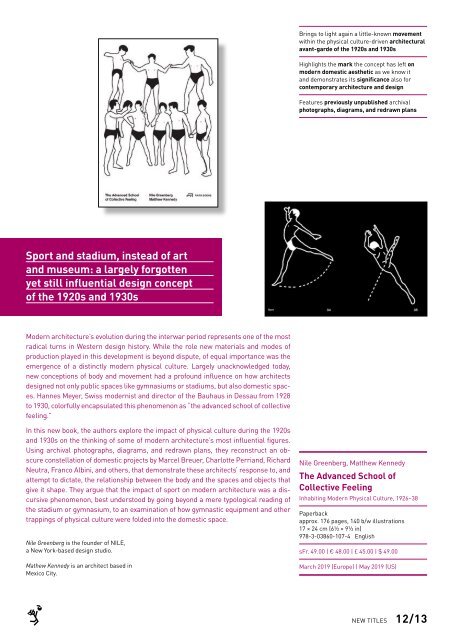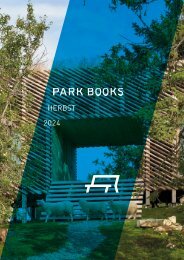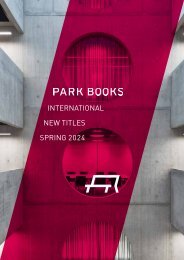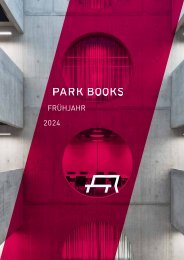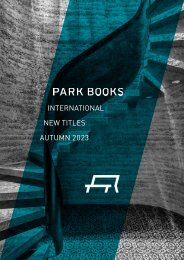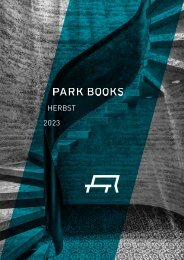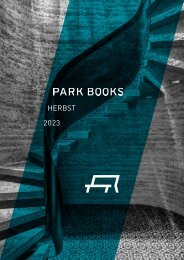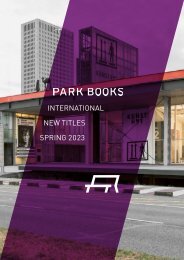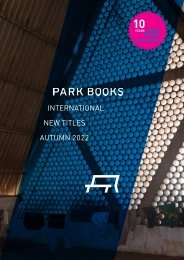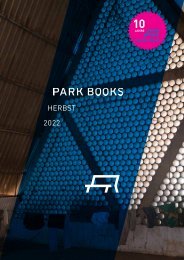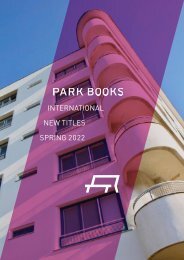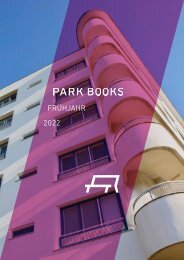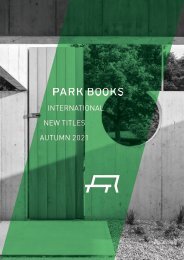Park Books New Titles Catalog 2018/19
The latest releases from Swiss based publishing house Park Books!
The latest releases from Swiss based publishing house Park Books!
Create successful ePaper yourself
Turn your PDF publications into a flip-book with our unique Google optimized e-Paper software.
Brings to light again a little-known movement<br />
within the physical culture-driven architectural<br />
avant-garde of the <strong>19</strong>20s and <strong>19</strong>30s<br />
Highlights the mark the concept has left on<br />
modern domestic aesthetic as we know it<br />
and demonstrates its significance also for<br />
contemporary architecture and design<br />
Features previously unpublished archival<br />
photographs, diagrams, and redrawn plans<br />
Sport and stadium, instead of art<br />
and museum: a largely forgotten<br />
yet still influential design concept<br />
of the <strong>19</strong>20s and <strong>19</strong>30s<br />
Modern architecture’s evolution during the interwar period represents one of the most<br />
radical turns in Western design history. While the role new materials and modes of<br />
production played in this development is beyond dispute, of equal importance was the<br />
emergence of a distinctly modern physical culture. Largely unacknowledged today,<br />
new conceptions of body and movement had a profound influence on how architects<br />
designed not only public spaces like gymnasiums or stadiums, but also domestic spaces.<br />
Hannes Meyer, Swiss modernist and director of the Bauhaus in Dessau from <strong>19</strong>28<br />
to <strong>19</strong>30, colorfully encapsulated this phenomenon as “the advanced school of collective<br />
feeling.”<br />
In this new book, the authors explore the impact of physical culture during the <strong>19</strong>20s<br />
and <strong>19</strong>30s on the thinking of some of modern architecture’s most influential figures.<br />
Using archival photographs, diagrams, and redrawn plans, they reconstruct an obscure<br />
constellation of domestic projects by Marcel Breuer, Charlotte Perriand, Richard<br />
Neutra, Franco Albini, and others, that demonstrate these architects’ response to, and<br />
attempt to dictate, the relationship between the body and the spaces and objects that<br />
give it shape. They argue that the impact of sport on modern architecture was a discursive<br />
phenomenon, best understood by going beyond a mere typological reading of<br />
the stadium or gymnasium, to an examination of how gymnastic equipment and other<br />
trappings of physical culture were folded into the domestic space.<br />
Nile Greenberg is the founder of NILE,<br />
a <strong>New</strong> York-based design studio.<br />
Mathew Kennedy is an architect based in<br />
Mexico City.<br />
Nile Greenberg, Matthew Kennedy<br />
The Advanced School of<br />
Collective Feeling<br />
Inhabiting Modern Physical Culture, <strong>19</strong>26–38<br />
Paperback<br />
approx. 176 pages, 140 b/w illustrations<br />
17 × 24 cm (6½ × 9½ in)<br />
978-3-03860-107-4 English<br />
sFr. 49.00 | € 48.00 | £ 45.00 | $ 49.00<br />
March 20<strong>19</strong> (Europe) | May 20<strong>19</strong> (US)<br />
NEW TITLES 12/13


